Definition. BMS in battery (Battery management system) is technology dedicated to the oversight of a battery pack, which is an assembly of battery cells, electrically organized in a row x column matrix configuration to enable delivery of targeted range of voltage and current for a duration of time against expected load scenarios.

BMS typically provides the following oversight:
In this context, the term “battery” refers to the entire pack; providing battery protection; estimating the battery’s operational state; continuously optimizing battery performance; reporting operational status to external devices. However, in the overall battery pack assembly, the monitoring and control functions are only applied to individual cells or groups of cells known as modules. With the highest energy density, lithium-ion rechargeable cells are the most common type of battery pack for a variety of consumer goods, including laptops and electric vehicles. Despite their excellent performance, they can be quite unforgiving when used outside of a tight safe operating area (SOA), with outcomes ranging from battery performance compromises to outright danger. The BMS’s overall complexity and oversight outreach may span multiple disciplines, including electrical, digital, control, thermal, and hydraulic, in addition to having a challenging job description.
How do systems for managing batteries function?
There is no one-of-a-kind set of requirements for battery management systems. There is typically a correlation between the technology’s implemented features and design scope:
There are numerous BMS in battery design features, with battery pack protection management and capacity management being two essential features. Application of the battery and any safety, lifespan, and warranty concerns Certification requirements from various government regulations. There are costs and penalties that are paramount if inadequate functional safety measures are in place. Here, we’ll talk about how these two features work. There are two main areas of battery pack protection management: Thermal protection, which entails passive or active temperature control to maintain or bring the pack into its SOA, and electrical protection, which entails not allowing the battery to be damaged by usage outside of its SOA.
What is battery management system in EV?

A battery management system is a critical component in an electric vehicle that manages and controls the rechargeable battery pack’s performance and health. It monitors the battery’s state of charge, state of health, and state of function, among other parameters, and ensures that the battery operates within its safe operating limits.
The BMS uses a combination of hardware and software to collect data from various sensors placed throughout the battery pack. This data is then processed by the BMS’s control algorithms, which make decisions about how to manage the battery pack’s energy flow and optimize its performance.
The primary functions of a BMS in an EV include:
- State of Charge (SOC) monitoring: The BMS in battery measures the battery’s SOC, which indicates the amount of energy remaining in the battery. It helps the driver estimate the range of the vehicle and plan charging.
- Thermal management: The BMS in battery monitors the temperature of the battery pack and ensures that it remains within safe limits to avoid overheating, which can damage the battery.
- Balancing: The BMS in battery balances the individual cell voltages in the battery pack, ensuring that all cells discharge and charge equally, thereby improving the battery’s overall performance and extending its life.
- Over-voltage protection: The BMS in battery protects the battery pack from over-voltage and under-voltage conditions, which can cause permanent damage to the battery.
- Cell monitoring: The BMS in battetry monitors individual cell voltages, temperature, and other parameters to detect any abnormalities or faults and isolate them to prevent further damage.
Overall, a Battery management system plays a crucial role in ensuring the safety, longevity, and optimal performance of an EV’s battery pack.
What are the types of BMS?
There are two main types of Battery management systems. The first is a centralized battery management system, which uses one control unit to manage all of the battery cells in the system. The second type of BMS is a distributed battery management system, which uses multiple control units to manage the battery cells in the system
What are the main components of the BMS?
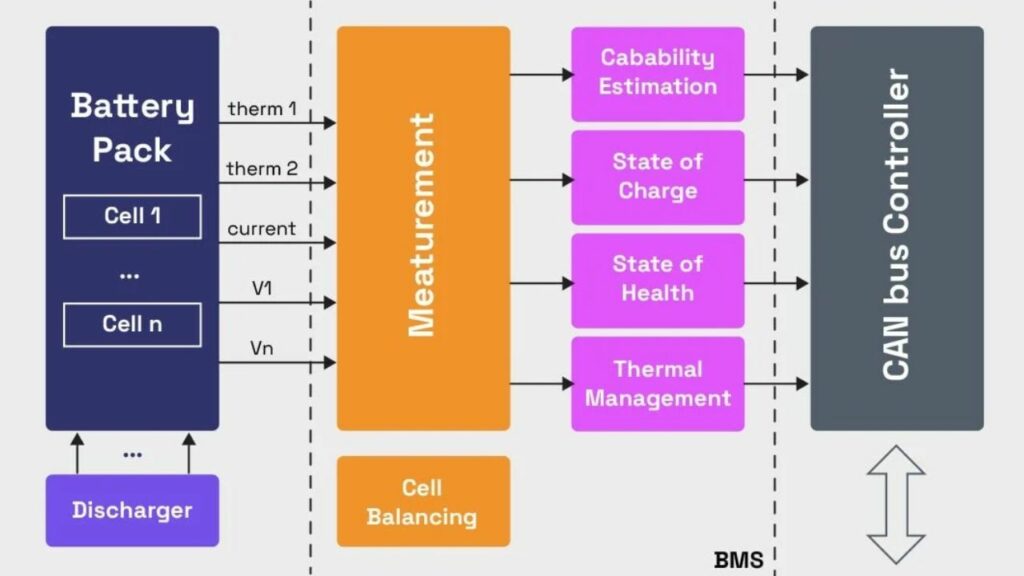
Mainly, there are 6 components of battery management system.
- Battery cell monitor.
- Cutoff FETs.
- Monitoring of Temperature.
- Cell voltage balance.
- BMSBMS Algorithms.
- Real-Time Clock (RTC)
What is the benefit of BMS in battery?
The primary function of the BMS in battery is to protect the battery cells from damage caused by being overcharged or over-discharged. Additionally, the battery management system calculates the remaining charge, monitors the battery’s temperature, monitors the battery’s health and safety by checking for loose connections and internal shorts.
What is a BMS for lithium batteries?
The BMS in battery is an intelligent component of a battery pack responsible for advanced monitoring and management. It is the brain behind the battery and plays a critical role in its levels of safety, performance, charge rates, and longevity.
Why do lithium-ion batteries need BMS?
The BMS in battery is needed to monitor important parameters such as environmental temperatures or a battery’s state of charge in operations. Because the lithium-ion cells differ in capacity when manufactured, each cell might be at a different state of charge.
Why is BMS necessary
It prolongs the life of your battery by defining an optimized range of use for electrochemical cells. It estimates battery ageing via SOH “State Of Health” and can tell you the number of cycles performed. It allows you to know in real time the state of charge of your battery thanks to the SOC “State Of Charge”.
How many types of BMS are there?
There are 2 types of BMS in battery:
Monitoring and targeting systems – designed to monitor energy use and target areas for improvement. Continuous commissioning systems – adjust your heating, ventilation, air conditioning (HVAC) and other systems continuously to meet demand.
Why do lithium-ion batteries need BMS?
The BMS in battery is needed to monitor important parameters such as environmental temperatures or a battery’s state of charge in operations. Because the lithium-ion cells differ in capacity when manufactured, each cell might be at a different state of charge.
What happens if BMS fails?
If the BMS in battery is not detected, this may lead to electric shock. Therefore, BMS systems have the highest requirements for monitoring sensors. Avoiding the failure of the monitoring system can greatly improve the safety of the power battery.
Can I use battery without BMS?
Well, actually, no – lithium batteries don’t need a battery management system (BMS) to operate. You can connect a few lithium battery cells in series to make a battery pack without any sort of lithium battery management system, and it will be able to power various loads and be charged just fine.
Protection against electrical management: Current
The way to electrical safety is to monitor the voltages of the cells or modules in a module or battery pack. Any battery cell’s electrical safe operating area is limited by current and voltage. A typical SOA for a lithium-ion cell is shown in Figure 1, and a well-designed battery management system will prevent operation outside of the manufacturer’s cell ratings to safeguard the pack. In order to extend the battery’s lifespan, further derating can frequently be used to stay within the SOA safe zone.
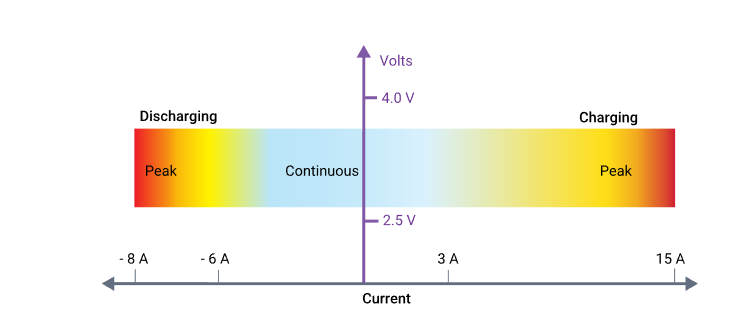
Both charging and discharging modes of lithium-ion cells can handle higher peak currents, albeit for brief periods of time, despite having different current limits. Maximum peak charging and discharging current limits are typically stipulated by battery cell manufacturers in addition to maximum continuous charging and discharging current limits. Maximum continuous current will almost certainly be applied by a BMS that protects against current. However, this could be delayed in order to take into account a sudden shift in load conditions; for instance, the sudden acceleration of an electric vehicle. By integrating the current and after delta time, a BMS in battery can incorporate peak current monitoring and decide whether to interrupt the pack current or reduce the available current. This enables the BMS to be forgiving of high peak demands as long as they are not excessive for an excessive amount of time while also possessing nearly instantaneous sensitivity to extreme current peaks, such as a short-circuit condition that has not been noticed by any resident fuses.
Protection against electrical management: Voltage
Figure 2 depicts the voltage range within which a lithium-ion cell must function. The intrinsic chemistry of the chosen lithium-ion cell and its temperature at any given time will ultimately establish these SOA boundaries. In addition, these SOA voltage limits are typically further restricted to maximize battery lifespan because any battery pack experiences a significant amount of current cycling, discharge due to load demands, and charging from a variety of energy sources. The BMS in battery will make decisions based on how close it is to these thresholds, so it must be aware of them. A BMS may, for instance, request a gradual reduction in charging current as the high voltage limit approaches or, if the limit is reached, the termination of charging current altogether. To stop control talk about the shutdown threshold, this limit is usually accompanied by additional intrinsic voltage hysteresis considerations. Then again, while moving toward the low voltage limit, a BMS will demand that key dynamic culpable burdens decrease their ongoing requests. This can be accomplished by lowering the maximum torque available to the traction motor in an electric vehicle. Naturally, the BMS in battery must prioritize driver safety while safeguarding the battery pack to prevent permanent damage.
Protection from Thermal Management: Temperature
Although lithium-ion cells appear to operate well across a wide temperature range, chemical reaction rates significantly slow down at low temperatures, reducing battery capacity overall. They perform better than lead-acid or NiMh batteries when it comes to their ability to operate at low temperatures; However, prudent temperature management is necessary because charging below 32 degrees Fahrenheit is physically challenging. During sub-freezing charging, the phenomenon of plating of metallic lithium can occur on the anode. This is extremely durable harm and results in diminished limit, yet cells are more defenseless against disappointment whenever exposed to vibration or other unpleasant circumstances. Through heating and cooling,the BMS in battery can regulate the battery pack’s temperature.
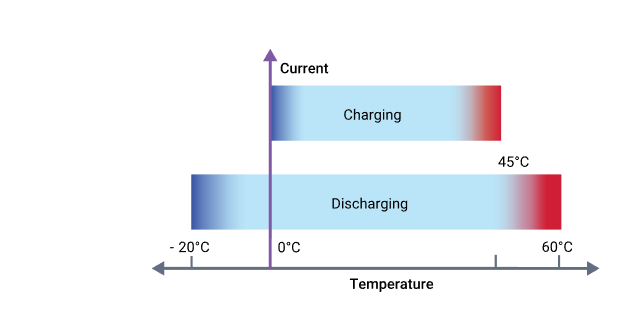
The size, cost, and performance goals of the battery pack, as well as the design criteria for the BMS in battery and the product unit, which may take into account the targeted geographic region (such as Alaska versus Hawaii), all play a role in realizing thermal management. Regardless of the kind of heater, it is usually more efficient to use an external AC power source or a different resident battery to power the heater when it is needed. Nonetheless, on the off chance that the electric warmer has an unassuming flow draw, energy from the essential battery pack can be directed to warm itself. An electric heater is used to heat the coolant that is pumped and distributed throughout the pack assembly if a thermal hydraulic system is implemented.
In order to channel heat energy into the pack, BMS in battery design engineers undoubtedly know a few tricks of the trade. For instance, the BMS’s capacity management-focused power electronics can be activated. While not generally so productive as immediate warming, it tends to be utilized in any case. A lithium-ion battery pack’s performance loss can be reduced significantly by cooling. For instance, a particular battery might perform best at 20°C; The pack’s performance efficiency may suffer a 20% decrease if its temperature rises to 30°C. The performance loss can reach a staggering 50% if the pack is continuously charged and recharged at 45°C (113°F). If the battery is constantly subjected to excessive heat generation, particularly during fast charging and discharging cycles, it may also experience premature aging and degradation. It is possible to use either of the passive or active cooling methods to achieve cooling. The battery is cooled by passive cooling, which relies on the movement of air flow. This indicates that an electric vehicle is simply traveling down the road. Notwithstanding, it very well might be surprisingly refined, as velocity sensors could be coordinated to decisively auto-change deflective air dams to augment wind current. An active temperature-controlled fan can help at low speeds or when the vehicle has stopped, but it can only bring the pack temperature down to the same level as the surrounding air. This could raise the temperature of the initial pack on extremely hot days. Thermal hydraulic active cooling can be designed as a complement to other systems. It typically uses ethylene-glycol coolant with a specific mixture ratio and is circulated through pipes/hoses, distribution manifolds, a cross-flow heat exchanger (radiator), and a cooling plate that is positioned against the battery pack assembly by means of an electric motor-driven pump. To ensure optimal battery performance, a BMS monitors pack temperatures and opens and closes various valves to keep the battery’s temperature within a narrow temperature range.
Managing Capacity
One of a BMS’s most important battery performance features is arguably the ability to maximize the capacity of a battery pack. A battery pack may eventually become useless if this maintenance is not performed. A battery pack’s “stack,” or series array of cells, is not perfectly equal and has slightly different leakage or self-discharge rates by definition. Although it may statistically be influenced by minute variations in the manufacturing process, leakage is not a manufacturer defect but rather a characteristic of the battery’s chemistry. A battery pack may initially have cells that are well-matched, but over time, not only as a result of self-discharge but also as a result of charge/discharge cycling, elevated temperature, and general calendar aging, the similarity between cells further deteriorates. Having said that, keep in mind the previous discussion about how lithium-ion cells perform exceptionally well but can be rather recalcitrant when operated outside of a strict SOA. We advanced beforehand about required electrical security since lithium-particle cells don’t manage over-charging. They can’t take any more current once they’re fully charged, and any extra energy put into them turns into heat, causing voltage to rise quickly and potentially to dangerous levels. If it continues, it could result in permanent damage to the cell as well as unsafe operating conditions.
The overall voltage of the battery pack is determined by the series cell array, and attempting to charge a stack presents a problem if there is a mismatch between adjacent cells. This is shown in Figure 3. Each cell will charge up equally if the set is perfectly balanced, and the charging current can be stopped when the upper 4.0 voltage cut-off threshold is reached. However, in the unbalanced scenario, the top cell will reach its charge limit early, necessitating the termination of the leg’s charging current prior to the full charge of the other underlying cells.
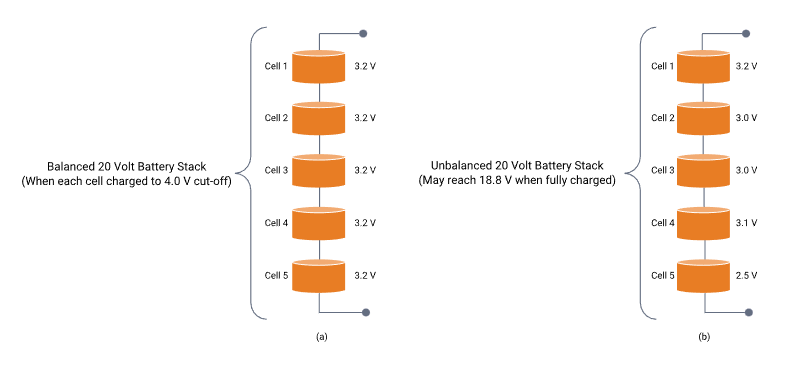
Ready-to-charge battery stack (a) balanced and (b) unbalanced | Synopsys Click to see the details The BMS in battery, or battery pack in this instance, steps in and saves the day. An important definition needs to be explained to demonstrate how this works. A cell or module’s state-of-charge (SOC) is proportional to the available charge in relation to the total charge when fully charged. As a result, a battery with a SOC of 50% indicates that it is 50% charged, similar to a fuel gauge’s merit value. Balanced SOC variation across each pack assembly stack is the primary focus of BMS capacity management. The SOC can be estimated using a variety of methods because it is not directly measurable. The balancing scheme itself generally falls into two main categories: passive and active. There are many different themes, and each one has advantages and disadvantages. The BMS design engineer is responsible for deciding which is best for the given battery pack and its intended use. The most straightforward method for implementing and explaining the general idea of balancing is passive balancing. Every cell in the stack can be charged to the same capacity as the weakest cell using the passive method. During the charging cycle, it transfers a small amount of energy from high SOC cells with a relatively low current to ensure that all cells charge to their maximum SOC. The BMS’s approach to this is depicted in Figure 4. It uses a transistor switch and a discharge resistor of the right size to monitor each cell in parallel. At the point when the BMS detects a given cell is moving toward its charge limit, it will control overabundance current around it to the following cell beneath in a hierarchical style.

Figure 5 depicts the before and after endpoints of the balancing process. In a nutshell, a BMS balances a battery stack by permitting a stack cell or module to see a charging current distinct from the pack current in one of the following ways:
Redirection of some or nearly all of the charging current around the most charged cells, thereby allowing the less charged cells to receive charging current for a longer period of time, removal of charge from the most charged cells, which provides headroom for additional charging current to prevent overcharging and allows the less charged cells to receive more charging current.

System types for managing batteries
The primary goal of battery management systems, which is to “take care of the battery,” can be achieved by employing a wide range of technologies and varying in complexity. On the other hand, these systems can be grouped according to their topology, which refers to the manner in which they are installed and function on the cells or modules that make up the battery pack.
Architecture of the centralized BMS in battery
consists of a single central BMS within the battery pack assembly. The central BMS in battery is directly connected to each battery package. Figure 6 depicts a centralized BMS’s structure. There are some benefits to the centralized BMS. Since there is only one BMS, it tends to be the most cost-effective and has a smaller footprint. However, a centralized BMS has some drawbacks. The BMS in battery needs a lot of ports to connect to all of the battery packages because all of the batteries are directly connected to it. This means heaps of wires, cabling, connectors, and so forth. in large battery packs, making maintenance and troubleshooting more difficult tasks.

Topology of BMS Modular
The BMS in battery is broken up into a number of duplicated modules, each of which has its own bundle of wires and connections to an assigned portion of a battery stack, just like in a centralized implementation. Look at Figure 7. These BMS submodules may be overseen by a primary BMS module whose job it is to keep an eye on their status and communicate with peripheral equipment. It is easier to troubleshoot and maintain because of the duplicated modularity, and it is simple to expand to larger battery packs. The downside is that overall costs are slightly higher and that, depending on the application, unused functionality may be duplicated.
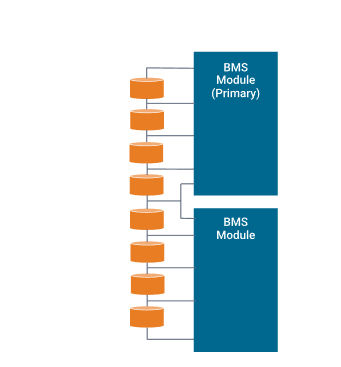
Primary/Subordinate BMS
Conceptually similar to the modular topology, this one confines the slaves to merely transmitting measurement data, while the master is devoted to computation, control, and communication with the outside world. As a result, the slaves’ functionality tends to be simpler, with likely less overhead and fewer unused features, which may result in lower costs than those of the modular versions.

Architecture for a Distributed BMS in battery
Quite distinct from the other topologies, in which the electronic hardware and software are encased in modules that connect to the cells through bundles of connected wiring. All of the electronic hardware in a distributed BMS is on a control board that is directly attached to the cell or module being monitored. The majority of the cabling is reduced to a few sensor wires and communication wires connecting adjacent BMS modules as a result. As a result, each BMS is more independent and can handle communications and computations as needed. However, despite its apparent simplicity, the integrated form’s location deep within a shield module assembly makes it difficult to troubleshoot and maintain. Because there are more BMSs in the overall structure of a battery pack, costs also tend to be higher.

The significance of systems for managing batteries
In the BMS in battery, functional safety is of the utmost importance. The voltage, current, and temperature of any cell or module under supervisory control must not exceed defined SOA limits during charging and discharging operations. In addition to compromising a potentially expensive battery pack, dangerous thermal runaway conditions may develop if limits are exceeded for an extended period of time. In addition, lower voltage threshold limits are closely monitored for functional safety and lithium-ion cell protection. Copper dendrites could eventually form on the anode of the Li-ion battery if it remains in this low-voltage state. This could increase self-discharge rates and raise potential safety concerns. The high energy density of systems powered by lithium-ion batteries comes at a cost that leaves little room for error in battery management. This is one of the most successful and safe battery chemistry that is currently available because of BMS in batteries and advancements in lithium-ion technology.
The next most important aspect of a BMS in battery is the battery pack’s performance, which includes electrical and thermal management. All of the cells in the pack need to be balanced in order to electrically maximize the overall battery capacity. This means that the SOC of adjacent cells throughout the assembly needs to be roughly equivalent. Not only can optimal battery capacity be achieved with this, but it also helps to prevent general degradation and reduces the likelihood of hotspots caused by overcharging weak cells. Lithium-particle batteries ought to stay away from release beneath low voltage limits, as this can bring about memory impacts and critical limit misfortune. Electrochemical cycles are profoundly helpless to temperature, and batteries are no special case. Capacity and available battery energy decrease significantly when the temperature of the environment drops. As a result, the BMS in battery might turn on resident heater plates that are installed underneath modules of a pack that is included in a helicopter or another aircraft, or an external in-line heater that resides on, for example, the liquid cooling system of an electric vehicle battery pack. Additionally, it is essential to first sufficiently raise the battery temperature because charging cold lithium-ion cells shortens their lifespan. The majority of lithium-ion cells cannot be fast-charged below 5°C and should not be charged at all below 0°C. BMS thermal management frequently ensures that a battery operates within a narrow Goldilocks region of operation (e.g., 30 – 35°C) for optimal performance during typical operational usage. As a result, performance is safeguarded, battery life is extended, and a healthy, dependable pack is created.
The advantages of systems for managing batteries
A whole battery energy capacity framework, frequently alluded to as BESS, could be comprised of tens, hundreds, or even a great many lithium-particle cells decisively stuffed together, contingent upon the application. These systems can have pack supply currents of up to 300A or more, and their voltage rating can be as low as 100V or as high as 800V. Any bungle of a high voltage pack could set off a hazardous, disastrous catastrophe. As a result, BMSs are absolutely necessary to ensure safe operation. The following is a summary of the advantages of BMSs:
Efficacy and security. For large-format lithium-ion battery packs, this is absolutely necessary and prudent. However, even the smaller formats utilized in laptops, for instance, have been known to catch fire and cause significant damage. There is little room for error in battery management when it comes to the personal safety of users of products that have systems powered by lithium-ion batteries.
Life Length and Unwavering quality. Battery pack assurance the executives, electrical and warm, guarantees that every one of the cells are undeniably utilized inside pronounced SOA necessities. This small oversight ensures that the cells are protected from aggressive use and fast charging and discharging cycles, inevitably leading to a stable system that could last many years.
Execution and Reach. Maximum battery capacity can be achieved through BMS battery pack capacity management, which uses cell-to-cell balancing to even out the SOC of adjacent cells across the pack assembly. A battery pack may eventually become useless without this BMS feature to account for variations in self-discharge, charge/discharge cycling, temperature effects, and general aging.
External communication, data collection, and diagnostics. Continuous monitoring of all battery cells is one type of oversight task. Data logging can be used for diagnostic purposes on its own, but it is typically used to estimate the SOC of all assembly cells. While this data is used by balancing algorithms, it can also be relayed to external devices and displays to show the battery pack’s state of health, estimate the expected range or range/lifetime based on current usage, and indicate the resident energy that is available.
Reduction of costs and warranties. Costs go up when a BMS is added to a BESS, and battery packs are expensive and could be dangerous. Safety requirements rise with system complexity, necessitating an increased BMS oversight presence. But a BMS’s protection and preventive maintenance in terms of safety, lifespan, reliability, performance, range, and diagnostics, among other things. assures that it will reduce overall costs, including warranty-related ones.
Systems and synopses for managing batteries
When it comes to exploring and resolving design issues during hardware development, prototyping, and testing, simulation is a useful partner for BMS design. The BMS architecture simulation model is the executable specification known as the virtual prototype with a precise lithium-ion cell model in play. Additionally, simulation makes it possible to examine various BMS oversight functions against a variety of battery and environmental operation scenarios in a straightforward manner. Problems with implementation can be found and looked into early, allowing improvements to performance and safety before they are implemented on the real hardware prototype. This helps ensure that the initial hardware prototype will be durable and speeds up development. Additionally, when used in physically realistic embedded system applications, the BMS and battery pack can be subjected to a variety of authentication tests, including worst-case scenarios.
Synopsys SaberRD provides engineers interested in BMS and battery pack design and development with extensive electrical, digital, control, and thermal hydraulic model libraries. Models can be quickly generated from basic datasheet specifications and measurement curves for a variety of electronic devices and battery chemistry types using tools. Measurable, stress, and shortcoming examinations license confirmation across ranges of the working locale, including limit regions, to guarantee in general BMS dependability. In addition, a lot of design examples are provided to help users get started on projects and quickly find the answers they need from simulation.
What is the disadvantage of BMS in battery?
The issue is that there will be large blind spots because most building management systems do not control smaller equipment. Because the cost to install, maintain, and utilize is so high, most properties with a BMS only have it installed on the major loads, such as large HVAC equipment and lighting.

















